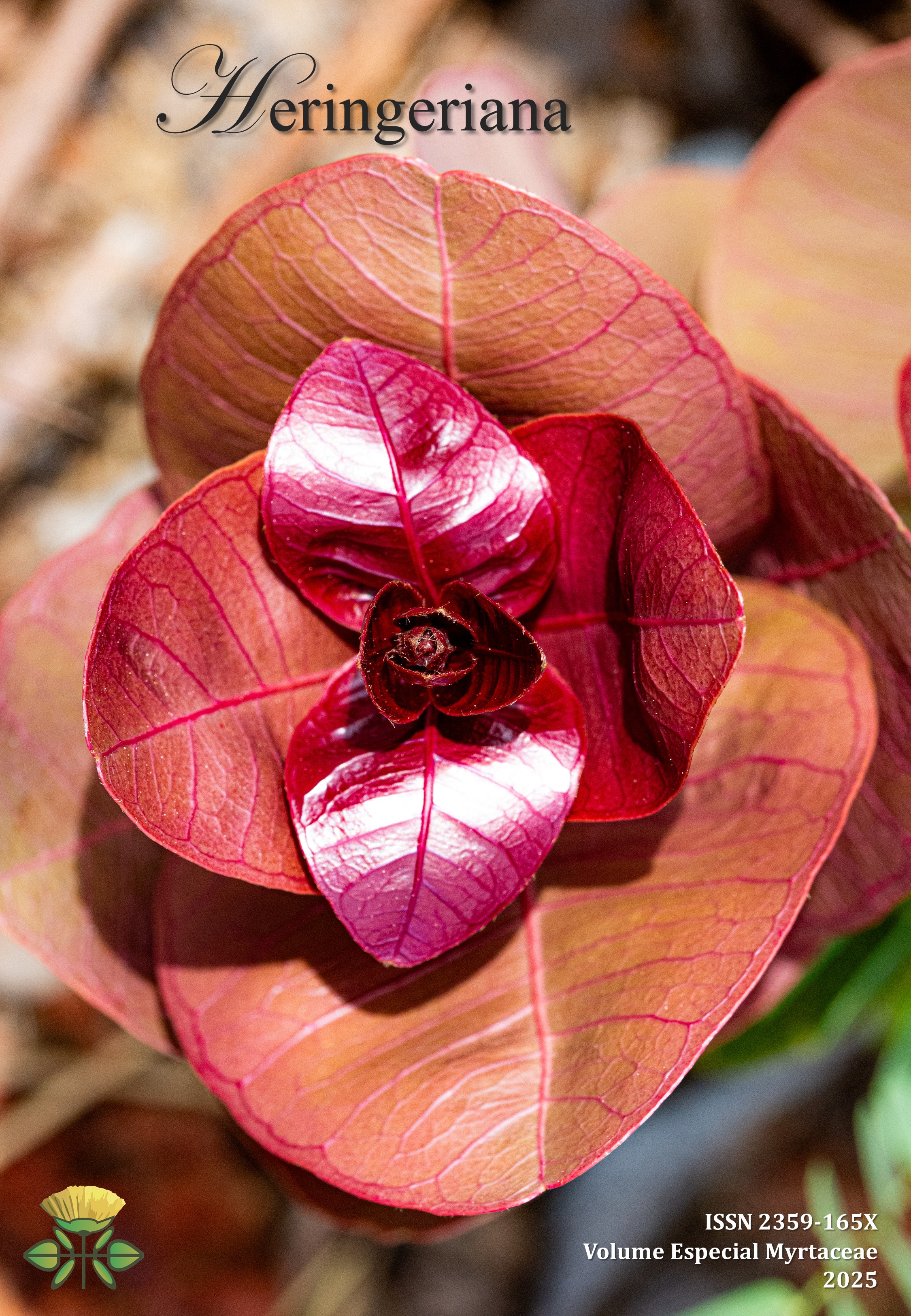A Review of Inflorescences in Myrteae (Myrtaceae): Concepts, Terminology and Usage
DOI:
https://doi.org/10.70782/heringeriana.v19ib.918069Palavras-chave:
neotropical, arquitetura da inflorescência, revisão sistemáticaResumo
Myrtaceae is a diverse family with a center of diversity in South America, Australia and Southeast Asia, whose ecological and evolutionary histories have been the focus of various studies. Such diversity also reflects into a rich variety of morphological, developmental, and evolutionary aspects, including the architecture of inflorescences. Here, we propose a systematic survey of the literature to better understand the profile and the approaches of scientific studies about inflorescences in general and then, specifically in myrtaceous plants of the tribe Myrteae. We found that most published works in this field focus on Monocotyledons, with China and the USA leading in number of publications. Transversal studies across plant families or focusing on important crops/models yield more citations. Ecological studies on inflorescences (especially pollination) have a strong theoretical framework, while structural, developmental, and evolutionary areas lack a common body of references. Scientific production is biased towards economically important plant families, neglecting biodiverse ones like Myrtaceae. Our results point out to the necessity of efforts toward a terminological unification/clarification and of morphological and ontogenetical studies to better circumscribe and describe inflorescences in myrtaceous plants, making results comparable allowing broader studies that may have important impacts in different fields of research.
Referências
Alvarez, J., Guli, C.L., Yu X.-H., & Smyth, D.R. (1992) Terminal flower: a gene affecting inflorescence development in Arabidopsis thaliana. Plant Journal 2: 103–116. https://doi.org/10.1111/j.1365-313X.1992.00103.x
Andrés, F. & Coupland, G. (2012) The genetic basis of flowering responses to seasonal cues. Nature Reviews Genetics 13(9):627-39. https://doi.org/10.1038/nrg3291
Aria, M., & Cuccurullo, C. (2017) Bibliometrix: an R-tool for comprehensive science mapping analysis. Journal of Informatics 11(4): 959–975. https://doi.org/10.1016/j.joi.2017.08.007
Bentham, G. (1869) Notes on Myrtaceae. The Journal of the Linnean Society. Botany 10: 101–166.
Berg, O. (1855) Revisio Myrtacearum Americae. Linnaea 27: 1-128.
Berg, O. (1857) Myrtaceae. In: von Martius, C.F.P. & Eichler, A.G. (Eds.) Flora Brasiliensis. vol. 14. F. Fleischer, Leipzig & Munich, pp. 1–468.
Bohte, A. & Drinnan, A. (2005) Floral development and systematic position of Arillastrum, Allosyncarpia, Stockwellia and Eucalyptopsis (Myrtaceae). Plant Systematics and Evolution 251: 53–70. https://doi.org/10.1007/s00606-004-0161-z
Bradley, D., Ratcliffe, O., Vincent, C., Carpenter, R., & Coen, E. (1997) Inflorescence commitment and architecture in Arabidopsis. Science 275(5296):80–3. https://doi.org/10.1126/science.275.5296.80
Briggs, B.G., & Johnson, L.A.S. (1979) Evolution in the Myrtaceae - Evidence from inflorescence structure. Proceedings of the Linnean Society of New South Wales 102(4): 157–254.
Carrucan, A.E. & Drinnan, A.N. (2000) The ontogenetic basis for floral diversity in the Baeckea sub-group (Myrtaceae). Kew Bulletin 55(3): 593–613. http://dx.doi.org/10.2307/4118778
Claßen-Bockhoff, R. & Bull-Hereñu, K. (2013) Towards an ontogenetic understanding of inflorescence diversity. Annals of Botany 112: 1523–1542. https://doi.org/10.1093/aob/mct009
Coen, E.S. & Meyerowitz, E.M. (1991) The war of the whorls: Genetic interactions controlling flower development. Nature 353(6339): 31–7. https://doi.org/10.1038/353031a0
Cuccurullo, C., Aria, M. & Sarto, F. (2016) Foundations and trends in performance management: A twenty-five years bibliometric analysis in business and public administration domains. Scientometrics 108: 595–611. http://dx.doi.org/10.1007/s11192-016-1948-8
De Candolle, A.P. (1827) Myrtacées. In: Bory de Saint-Vincent, J.B.G.M. (Ed.) Dictionnaire classique d’histoire naturelle 11: 399–407.
Endress, P.K. (2010) Disentangling confusions in inflorescence morphology: Patterns and diversity of reproductive shoot ramification in angiosperms. Journal of Systematics and Evolution 48: 225–239. https://doi.org/10.1111/j.1759-6831.2010.00087.x
Fu, H.Z.& Waltman, L. (2022) A large-scale bibliometric analysis of global climate change research between 2001 and 2018. Climatic Change 170: 36. https://doi.org/10.1007/s10584-022-03324-z
Gonçalves, E.G. & Lorenzi, H. (2011) Morfologia vegetal: organografia e dicionário ilustrado de morfologia das plantas vasculares. Second Edition. Instituto Plantarum, Nova Odessa. 544 pp.
Govaerts, R., Sobral, M., Ashton, P., Barrie, F., Holst, B.K., Landrum, L.R., Matsumoto, K., Mazine, F.F., Nic Lughadha, E., Proença, C.E.B., Soares-Silva, L., Wilson, P.G. & Lucas, E. (2017) World Checklist of Myrtaceae. In: World Checklist of Selected Plant Families. Facilitated by the Royal Botanic Gardens, Kew. Disponível em: http://apps.kew.org/wcsp/ (acesso: 23 Março 2017).
Hanano, S. & Goto, K., (2011) Arabidopsis TERMINAL FLOWER1 is involved in the regulation of flowering time and inflorescence development through transcriptional repression. The Plant Cell 23(9): 3172–3184. https://doi.org/10.1105/tpc.111.088641
Heisler, M.G., Ohno, C., Das, P., Sieber, P., Reddy, G.V., Long, J.A. & Meyerowitz, E.M. (2005) Patterns of auxin transport and gene expression during primordium development revealed by live imaging of the Arabidopsis inflorescence meristem. Current Biology 15(21):1899-911. http://doi.org/10.1016/j.cub.2005.09.052
Hickey, L.J. (1973) Classification of the architecture of dicotyledonous leaves. American Journal of Botany 60: 17–33.
Hickey, M. & King, C. (2000) The Cambridge illustrated glossary of botanical terms. Cambridge University Press, Cambridge, 208 pp.
Huang, J., Chen, Y., Pan, J., Liu, W., Yang, G., Xiao, X., Zheng, H., Tang, W., Tang, H. & Zhou, L. (2019) Carbon footprint of different agricultural systems in China estimated by different evaluation metrics. Journal of Cleaner Production 225: 939–948. http://dx.doi.org/10.1016/j.jclepro.2019.04.044
Karlsson, A. & Nordén, L. (2007) Home sweet home: Home bias and international diversification among individual investors. Journal of Banking and Finance 31(2): 317–333. https://doi.org/10.1016/j.jbankfin.2006.04.005
Kellogg, E.A. (2000) The Grasses: A Case Study in Macroevolution. Annual Review of Ecology, Evolution, and Systematics 31, 217-238. https://doi.org/10.1146/annurev.ecolsys.31.1.217
Landrum, L.R. & Kawasaki, M.L. (1997) The genera of Myrtaceae in Brazil: an illustrated synoptic treatment and identification keys. Brittonia 49, 508–536. https://doi.org/10.2307/2807742
Legrand, C.D. & Klein, R.M. (1978) Mirtáceas: Myrciaria. In: Reitz, R. (ed.) Flora ilustrada catarinense. Herbário Barbosa Rodrigues, Itajaí, pp. 733-876.
Leitão Filho, H.F. (1987) Considerações sobre a florística de florestas tropicais e subtropicais do Brasil. Boletim do Instituto de Pesquisas e Estudos Florestais 35:41–46.
Lucas, E.J., Amorim, B.S., Lima, D.F., Lima-Lourenço, A.R., Nic Lughadha, E.M., Proença, C.E.B., Rosa, P.O., Rosário, A.S., Santos, L.L., Santos, M.F., Souza, M.C., Staggemeier, V.G., Vasconcelos, T.N.C. & Sobral, M. (2018) A new infra-generic classification of the species-rich Neotropical genus Myrcia s.l.. Kew Bulletin 73: 9. https://doi.org/10.1007/s12225-017-9730-5
Lucas, E.J. & Bünger, M.O. (2015) Myrtaceae in the Atlantic forest: their role as a ‘model’ group. Biodiversity and Conservation 24: 2165–2180. http://doi.org/10.1007/s10531-015-0992-7
Lucas, E.J., Harris, S.A., Mazine, F.F., Belsham, S.R., Nic Lughadha, E.M., Telford, A., Gasson, P.E. & Chase, M.W. (2007) Suprageneric phylogenetics of Myrteae, the generically richest tribe in Myrtaceae (Myrtales). Taxon 56: 1105-1128. http://dx.doi.org/10.2307/25065906
Lucas, E.J., Holst, B.K., Sobral, M.E.G., Mazine, F.F., Nic Lughadha, E., Proença, C.E.B., Costa, I.R. & Vasconcelos, T.N.C. (2019) A new subtribal classification of tribe Myrteae (Myrtaceae). Systematic Botany 44: 560–569.
Lucas, E.J., Matsumoto, K, Harris, S.A., Nic Lughadha, E.M., Benardini, B. & Chase, M.W. (2011) Phylogenetics, morphology, and evolution of the large genus Myrcia s.l. (Myrtaceae). International Journal of Plant Sciences 172(7):915–934. https://doi.org/10.1600/036364419X15620113920608
Marks, R.A., Amézquita, E.J., Percival, S., Rougon-Cardoso, A., Chibici-Revneanu, C., Tebele, S.M., Farrant, J.M., Chitwood, D.H. & VanBuren, R. (2023) A critical analysis of plant science literature reveals ongoing inequities. Proceedings of the National Academy of Sciences 120 (10): e221756412. https://doi.org/10.1073/pnas.2217564120
Mazine, F.F., Souza, V.C., Sobral, M. Forest, F. & Lucas, E. (2014) A preliminary phylogenetic analysis of Eugenia (Myrtaceae: Myrteae), with a focus on Neotropical species. Kew Bulletin 69: 94–97. https://doi.org/10.1007/s12225-014-9497-x
McVaugh, R. (1956) Tropical American Myrtaceae: notes on generic concepts and description of previously unrecognized species. Fieldiana: Botany 29 (3): 145–228.
McVaugh, R. (1968) The genera of American Myrtaceae – an interim report. Taxon 17: 354–418.
Molina, A., Acedo, C. & Llamas, F. (2012) A comparative study of the inflorescence in the genus Carex (Cyperaceae). Systematic Botany 37(2): 365–381. https://doi.org/10.1600/036364412X635430
Mori, S.A., Boom, B.M., Carvalino, A.M. & Santos, T.S. (1983) Ecological importance of Myrtaceae in an eastern Brazilian wet forest. Biotropica 15(1): 68–70.
Murray-Smith, C., Brummitt, N.A., Oliveira-Filho, A.T., Bachman, S., Moat, J., Lughadha, E.M.N. & Lucas, E.J. (2009) Plant diversity hotspots in the atlantic coastal forests of Brazil. Conservation Biology 23(1): 151–63. https://doi.org/10.1111/j.1523-1739.2008.01075.x
Oliveira-Filho, A.T. & Fontes, M.A.L. (2000) Patterns of floristic differentiation among Atlantic forests in SE Brazil and the influence of climate. Biotropica 32: 793–810. https://doi.org/10.1111/j.1744-7429.2000.tb00619.x
Oliveira-Filho, A.T., Jarenkow., J. A. & Rodal, M.J.N. (2006) Floristic relationships of seasonally dry forests of eastern South America based on tree species distribution patterns. In: Pennington, R.T., Ratter, J.A. & Lewis, G.P. (Orgs.) Neotropical savannas and dry forests: Plant diversity, biogeography and conservation. CRC Press, Boca Raton, pp. 159–192. http://dx.doi.org/10.1201/9781420004496.ch7
Paulino, J.V., Groppo, M. & Teixeira, S.P. (2011) Floral developmental morphology of three Indigofera species (Leguminosae) and its systematic significance within Papilionoideae. Plant Systematics and Evolution 292 (3/4): 165–76. http://dx.doi.org/10.1007/s00606-010-0405-z
Peixoto, A.L. & Gentry, A. (1990) Diversidade e composição florística da mata de tabuleiro na Reserva Florestal de Linhares (Espírito Santo, Brasil). Revista Brasileira de Botânica 13:19–25.
Pessoa, E.M., Alves, M., Alves-Araújo, A., Palma-Silva, C. & Pinheiro, F. (2012) Integrating different tools to disentangle species complexes: A case study in Epidendrum (Orchidaceae). Taxon 61: 721–734. https://doi.org/10.1002/tax.614002
POWO (2023). Plants of the World Online, facilitated by the Royal Botanic Gardens, Kew. Disponível em: http://www.plantsoftheworldonline.org/ (acesso: 28 Maio 2023).
Prenner, G., Vergara-Silva, F. & Rudall, P.J. (2009) The key role of morphology in modelling inflorescence architecture. Trends in Plant Science 14: 302–309. https://doi.org/10.1016/j.tplants.2009.03.004
Proença, C.E.B. (1990) A revision of Siphoneugena Berg (Myrtaceae, Myrteae). Edinburgh Journal of Botany 47: 239-271. https://doi.org/10.1017/S0960428600003401
Proença, C.E.B., Lughadha, E.N., Lucas, E.J. & Woodgyer, E.M. (2006) Algrizea (Myrteae, Myrtaceae) a new genus from the highlands of Brazil. Systematic Botany 31: 320–326. http://doi.org/10.1600/036364406777585874
Prusinkiewicz, P., Erasmus, Y., Lane, B., Harder, L.D. & Coen, E. (2007) Evolution and development of inflorescence architectures. Science 316(5830):1452–1456. https://doi.org/10.1126/science.1140429
Pyke, G.H. (1978) Optimal foraging: Movement patterns of bumblebees between inflorescences. Theoretical Population Biology 13(1): 72-98. https://doi.org/10.1016/0040-5809(78)90036-9.
R Development Core Team (2023) R: A language and environment for statistical computing R Foundation for Statistical Computing, Vienna, Austria. Disponível em: https://www.r-project.org/ (acesso: 28 Maio 2023).
Radford, A.E., Dickson, W.C., Massey, J.R. & Bel, C.R. (1974) Vascular plant systematics. Harper & Row, New York.
Raposo, M.A., Kirwan, G.M., Lourenço, A.C.C., Sobral, G., Bockmann, F.A. & Stopiglia, R. (2020) On the notions of taxonomic ‘impediment’, ‘gap’, ‘inflation’ and ‘anarchy’, and their effects on the field of conservation. Systematics & Biodiversity 19: 296–311. https://doi.org/10.1080/14772000.2020.1829157
Ratcliffe, O.J., Amaya, I., Vincent, C.A., Rothstein, S., Carpenter, R., Coen, E.S. & Bradley, D.J. (1998) A common mechanism controls the life cycle and architecture of plants. Development 125(9):1609–1615. https://doi.org/10.1242/dev.125.9.1609
Reinheimer, R. & Vegetti, A.C. (2008) Inflorescence diversity and evolution in the PCK Clade (Poaceae: Panicoideae: Paniceae). Plant Systematics and Evolution 275: 133–167. https://doi.org/10.1007/S00606-008-0057-4
Schmid, R. (1972) A resolution of the Eugenia-Syzygyum controversy (Myrtaceae). American Journal of Botany 59: 423–436.
Snow, N., Callmander, M. & Phillipson, P.B. (2015) Studies of Malagasy Eugenia - IV: Seventeen new endemic species, a new combination, and three lectotypifications; with comments on distribution, ecological and evolutionary patterns. PhytoKeys 49: 59–121. https://doi.org/10.3897/phytokeys.49.9003
Snow, N., Rabenantoandro, J., Randriatafika, F., Rabehevitra, D., Razafimamonjy, N.D. & Cable, S. (2012) Studies of Malagasy Eugenia (Myrtaceae)—III: Seven new species of high conservation concern from the eastern littoral forests. Phytotaxa 48: 39–60. https://doi.org/10.11646/phytotaxa.48.1.7
Sobral, M. (2013) Eight new atlantic rainforest species and nomenclatural notes on Brazilian Myrtaceae. Phytotaxa 135: 43–61. https://doi.org/10.11646/phytotaxa.135.1.6
Sokoloff, D., Rudall, P.J. & Remizowa, M. (2006) Flower-like Terminal Structures in Racemose Inflorescences: A Tool in Morphogenetic and Evolutionary Research. Journal of Experimental Botany 57(13): 3517–30. https://doi.org/10.1093/jxb/erl126
Stadnik, A., Caldas, D.K.D. & Souza, M.C. (2023) Plinia In: Flora e Funga do Brasil. Jardim Botânico do Rio de Janeiro. Disponível em: https://floradobrasil.jbrj.gov.br/FB126989. (acesso:28 Maio 2023).
Stephenson, A.G. (1981) Flower and fruit abortion: Proximate causes and ultimate functions. Annual Review of Ecology and Systematics 12: 253–279. https://doi.org/10.1146/annurev.es.12.110181.001345
Troll, W. (1964) Die Infloreszenzen. Typologie und Stellung im Außau des Vegetationskörpers. Band 1. Fischer, Stuttgart.
Troll, W. (1969) Die Infloreszenzen. Typologie und Stellung im Außau des Vegetationskörpers. Band 2. Fischer, Stuttgart.
Tydecks, L., Jeschke, J.M., Wolf, M., Singer, G. & Tockner, K. (2018) Spatial and topical imbalances in biodiversity research. Plos one 13(7): e0199327. https://doi.org/10.1371/journal.pone.0199327
Vasconcelos, T.N.C., Prenner, G., Bünger, M.O., De-Carvalho, P.S., Wingler, A. & Lucas, E.J. (2015) Stamen position in Myrteae. Botanical Journal of the Linnean Society 179: 388–402. https://doi.org/10.1111/boj.12328
Weberling, F. (1989) Morphology of flowers and inflorescences. Cambridge University Press, Cambridge.
Weberling, F. (1988a) Inflorescence structure in primitive angiosperms. Taxon 37: 657–690.
Weberling, F. (1988b). The architecture of inflorescences in the Myrtales. Annals of the Missouri Botanical Garden 75: 226-310.
Weberling, F. (1992) Morphology of flowers and Inflorescences. Cambridge University Press, Cambridge.
Weigel, D., Alvarez, J., Smyth, D.R., Yanofsky, M.F. & Meyerowitz, E.M. (1992) LEAFY controls floral meristem identity in Arabidopsis. Cell 69(5): 843–859. https://doi.org/10.1016/0092-8674(92)90295-n
Willson, M.F. & Price, P.W. (1977) The evolution of inflorescence size in Asclepias (Asclepiadaceae). Evolution 31: 495–511.
Wilson, M.F. & Rathcke, B.J. (1974). Adaptive design of floral display in Asclepias syriaca L. American Midland Naturalist 92: 47–57.
Wilson, P.G., O’Brien, M.M., Gadek, P.A. & Quinn, C.J. (2001) Myrtaceae revisited: A reassessment of infrafamilial groups. American Journal of Botany 88: 2013–2025. https://doi.org/10.2307/3558428
Wyatt, R. (1982) Inflorescence architecture: How flower number, arrangement, and phenology affect pollination and fruit-set. American Journal of Botany 69: 585–594. https://doi.org/10.1002/j.1537-2197.1982.tb13295.x
Downloads
Arquivos adicionais
Publicado
Como Citar
Edição
Seção
Licença
Copyright (c) 2025 Marcelo Tomé Kubo, Paulo T Sano, Eve J Lucas

Este trabalho está licenciado sob uma licença Creative Commons Attribution 4.0 International License.
Ao fazer a submissão, os autores declaram não ter submetido o trabalho a outra revista e concordam em ter seu artigo publicado sob Licença Creative Commons Atribuição 4.0 Internacional BY (CC BY 4.0), que significa que os autores mantêm a propriedade dos direitos autorais, mas qualquer pessoa pode usar o conteúdo publicado, desde que os autores originais e a fonte sejam citados. O conteúdo científico, ortográfico e gramatical é de total responsabilidade dos autores.








